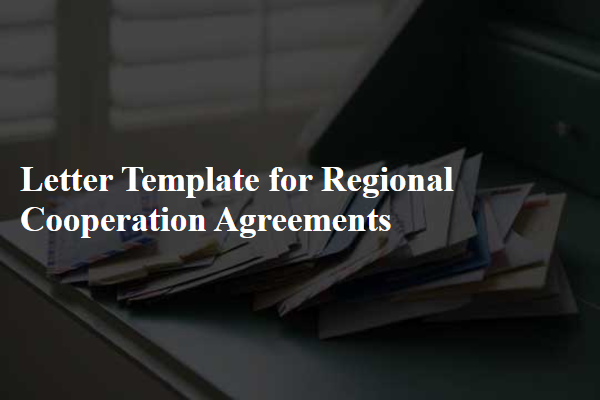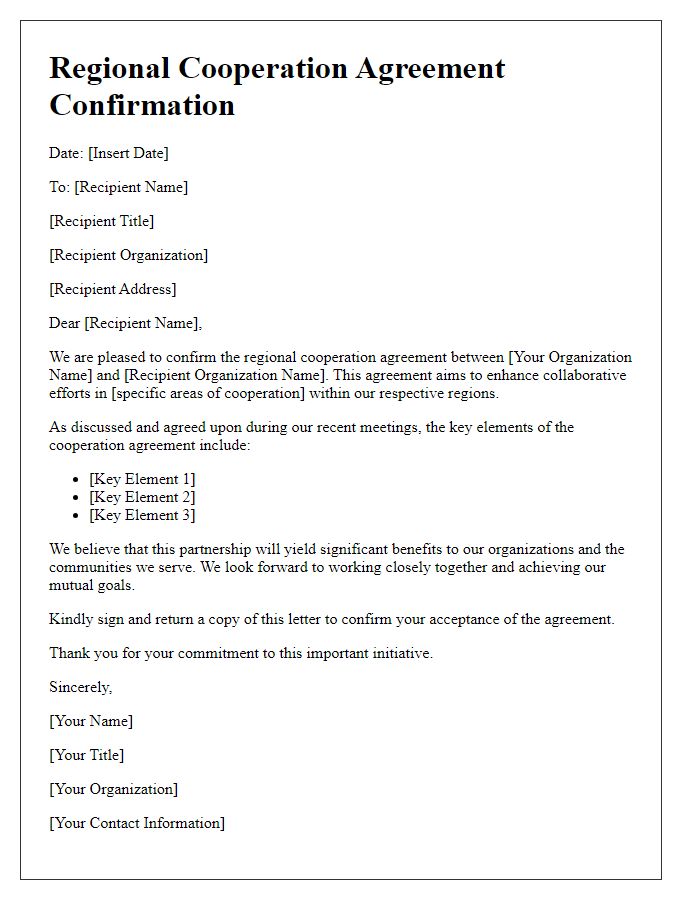Are you looking to strengthen regional ties and enhance collaboration? Crafting the right letter to propose a regional cooperation agreement can set the stage for successful partnerships and meaningful initiatives. In this article, we'll walk you through the essential elements of a compelling letter template that ensures your intentions are clear and engaging. So, let's dive in and explore how you can make your proposal stand out!

Introduction and Objective Statement
Regional cooperation agreements aim to foster collaboration among neighboring countries to address common challenges, promote economic development, and enhance security. These agreements often focus on mutual benefits, such as trade; cultural exchange, exemplified by programs shared between regions like the European Union, which comprises 27 member states; environmental sustainability, particularly in areas like the Amazon rainforest involving multiple South American nations; and healthcare initiatives addressing shared public health issues, demonstrated during global events like the COVID-19 pandemic. Establishing a framework for dialogue and joint action lays the groundwork for a more resilient and united regional strategy, ultimately enhancing the quality of life for citizens across borders.
Key Terms and Definitions
Regional cooperation agreements facilitate collaborative initiatives among neighboring countries, promoting economic growth and social development. Key terms include "Bilateral Agreements" where two nations engage in specific projects, "Multilateral Agreements" involving multiple parties working towards common goals, and "Joint Ventures," which represent shared investments for mutual benefit. Definitions such as "Cross-Border Cooperation" highlight the synergy in addressing issues that transcend national boundaries, while "Capacity Building" emphasizes strengthening skills and capabilities within communities. Understanding these terms fosters effective partnerships, enabling regions to tackle challenges such as trade barriers, environmental impacts, and cultural exchanges more effectively. Specific examples include the North American Free Trade Agreement (NAFTA), which exemplifies economic cooperation between the United States, Canada, and Mexico.
Areas of Cooperation
Regional cooperation agreements focus on various critical areas aimed at enhancing collaboration. These areas include economic development, emphasizing trade partnerships and investment opportunities among member regions. Environmental sustainability addresses collective efforts to combat climate change and promote resource management initiatives that protect ecosystems. Cultural exchange fosters mutual understanding through programs that highlight the diverse traditions and histories of the regions. Security cooperation enhances safety through joint training exercises, intelligence sharing, and coordinated responses to regional threats. Health cooperation establishes frameworks for addressing public health issues, facilitating information sharing among healthcare systems, and preparing for potential pandemics. Each area contributes to strengthened relationships and shared objectives among participating regions.
Implementation and Monitoring Mechanisms
Regional cooperation agreements typically establish frameworks for collaboration among member states. Implementation mechanisms ensure that commitments are met within specified timelines, potentially including task forces or dedicated units. Monitoring mechanisms consist of periodic reviews, reports, and evaluations conducted by appointed committees. Data collection methodologies, such as surveys and participatory assessments, allow for effective tracking of progress. Moreover, indicators measuring outcomes, such as economic growth rates or environmental preservation, are essential for evaluating success. Regular communication channels, including workshops or conferences, facilitate dialogue among stakeholders, promoting transparency and accountability in the cooperative efforts.
Signatories and Contact Information
Regional cooperation agreements rely on key signatories from various governmental and non-governmental organizations, facilitating collaboration for mutual benefits. Essential details include the names of member countries or regions, specifying their leaders or authorized representatives, their respective roles, and the capacities in which they are signing (e.g., Minister of Foreign Affairs, Governor). Additionally, contact information such as email addresses, phone numbers, and official mailing addresses enhance communication efficiency. Information regarding the effective date of the agreement and any relevant clauses for modifications or renewals must also be included to ensure clarity in obligations among signatories.
Letter Template For Regional Cooperation Agreements Samples
Letter template of regional cooperation agreement partnership invitation













Comments